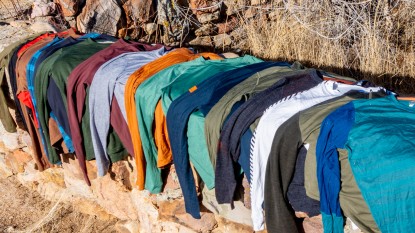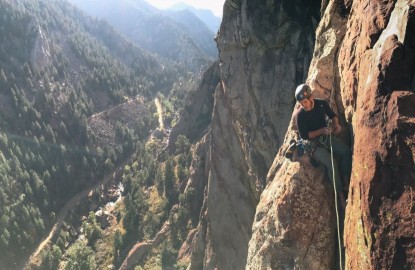Icebreaker did good work with the Sprint Crew. This baselayer is light but warm and even has nifty thumb-holes for additional comfort. It beat out fierce competition during field testing to win our Editors' Choice award. While other baselayers may be softer, cheaper, or more breathable, the Icebreaker Sprint Crew is what we grab when the weather looks temperamental. We use it for everything, from whitewater kayaking to big wall climbing to wolf tracking.
This baselayer, while comfortable, is designed for movement. For something a bit more cozy, try the Ibex Zepher [sic]. If the $100 price tag for the Sprint Crew seems a bit steep, go synthetic with the Patagonia Capilene 2 or 3.Icebreaker Sprint Crew Review
Our Verdict
Our Analysis and Test Results
The Icebreaker Sprint Crew baselayer is merino wool, with a bit lycra for stretch. It's our favorite baselayer by a significant margin. The Sprint Crew possesses a unique and remarkable blend of fit, weight and warmth. By making it snug but thin, Icebreaker allowed the Sprint Crew to comfortable perform through a huge range of temperatures. This layer is comfortable in nearly any condition, from spring rains to heavy winter storms. If we had to choose one baselayer from the myriad we tested, the Icebreaker Sprint Crew would be it.
Comfort/Fit:
The Icebreaker Sprint Crew is the best fitting baselayer of those we tested. The sleeves are long enough to fit even our most ape-ish testers. It isn't too tight around the chest, and the torso is long enough to tuck into pants. Overall, the fit is consistently snug but never tight. Icebreaker added a little lycra to improve the stretch, which helps keep everything in place. Because the Sprint Crew fits snugly, it's easy to put on additional layers. We could fit a T-shirt, the Ibex Zepher and Patagonia R1 over it without any bunching.
It may not be the most comfortable layer for sleeping or lounging around the house, but we'd gladly make that compromise.
Warmth:
Ounce for ounce, the Icebreaker Sprint Crew was the warmest baselayer we tested. Some combination of the wool, thickness, fit and witchcraft allows the Sprint Crew to outperform baselayers twice its weight. Throughout our testing, we never found a temperature that the Sprint Crew couldn't handle. During a particularly windy gthree-day ascent of the Lost Arrow Spire Direct route, our tester stayed warm with only the Icebreaker Sprint Crew and Patagonia R1, while his partner shivered beneath a down jacket.
On the other end of the spectrum, the Sprint Crew stayed comfortable well into the 50s. At 60 degrees, we felt like switching to a layer that breathed a bit better, like the Patagonia Capilene 3.
The Sprint Crew's superb temperature regulation could have won it Editors' Choice alone, but the Sprint Crew had even more to offer.
Wicking:
Of the wool baselayers, the Icebreaker Sprint Crew wicked the best. At higher temperatures, the wool just couldn't keep up with synthetic. That being said, the damp wool felt much better than damp Capilene. Capilene dries faster, but the slick synthetic material felt clammy in comparison to the wool, which absorbed much more sweat before it began to feel damp.
In colder conditions, the Sprint Crew truly excelled. On hard, fast climbs during winter days in the backcountry, we reached the top warm, not wet. The Sprint Crew fits in seamlessly to the classic baselayer-insulation-waterproof layering system. It's perfect for any cold-weather backcountry outing.
Best Application:
The Icebreaker Sprint Crew is at its best in cold weather, and as part of a layering system. We found it ideal as our next-to-skin layer for backcountry skiing. We kept it on all day, alternating the layers above it as our needs and temperature changed.
We also used it on alpine climbs and while cold-weather cragging, though a permanent baselayer is problematic while climbing. The temperature fluctuations between climbing and belaying are huge, so we usually prefer a light jacket to a baselayer. The jacket is easier to take off and easier to stow.
Winter trail running is another great application for the Sprint Crew. The form-fitting lycra and suppleness of merino is a great combination for running, and it's warm enough wear as a single layer in the coldest conditions.
Value
At $100, the Icebreaker Sprint Crew is expensive. You could by two or three synthetic layers for the same price. But we believe that this layer is worth it. Baselayers typically last a long time (unless you climb offwidths in them). The GT probably will not have a significantly longer life than any other baselayer we tested, but it will keep you much happier over the course of it.
Additional Features:
The Icebreaker Spring Crew has thumb holes! These added a bit of extra warmth and kept the sleeves from riding up during periods of high activity. They didn't sway our decision immensely, but little details and considerations go a long way.
Icebreaker includes a “baacode” with each garment, which allows you to trace the wool back to its farm of origin. We thought that was pretty nifty. Not a selling point, but it helps establish Icebreaker as a responsible, transparent company.
Other Versions
This crew top also comes in the zip version for $110, the Sprint Crew Zip.




